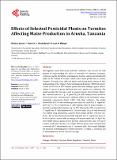Effects of Selected Pesticidal Plants on Termites Affecting Maize Production in Arusha, Tanzania

View/
Date
2020-03-27Author
James, Shaban
Ndakidemi, Patrick
Mbega, Ernest
Metadata
Show full item recordAbstract
Investigations under laboratory and field conditions were carried out with
purpose of understanding the effects of pesticides of Cupressus lusitanica,
Tephrosia vogelii, Eucalpytus dalrympleana, Lantana camara and Azadirachta
indica in the control of termites which affect maize production in Arusha,
Tanzania. Termites were collected before and during maize season of 2018
and identified at the Tropical Pesticides Research Institute (TPRI) laboratory.
A total of 5279 out of 5307 termite species identified belong to genus Macrotermes, 23 species to genus Odontotermes and 5 species were unknown. The
results entailed that the area is rich in species of genus Macrotermes. Moreover, concentrations i.e. 5 g, 10 g and 20 g of each botanical were tested for
Macrotermes spp. mortality and repellency ability in the laboratory using a
completely randomized design (CRD) with three replicates. The results
showed that 98.33% Macrotermes spp. mortality was caused by T. vogelii followed by 93.33% recorded from E. dalrympleana after 24 hours. Besides, C.
lusitanica repelled Macrotermes spp. by 97% followed by 95% recorded from
T. vogelii and E. dalrympleana each. For field trials, 20 g of each botanical
was applied using randomized complete block design (RCBD) with four replicates. The results obtained from field indicated that T. vogelii was more effective to protect maize with an average of 6 maize stands and 3.4 kg of dry
total weight of maize grains next to positive control per plot. Also, average of
4 maize stands and 3 kg dry total weight of maize grains were recorded from
treatments of E. dalrympleana and C. lusitanica each. Such results highlight
the potential of developing bio-termiticides from T. vogelii, C. lusitanica and
E. dalrympleana to control Macrotermes spp.
